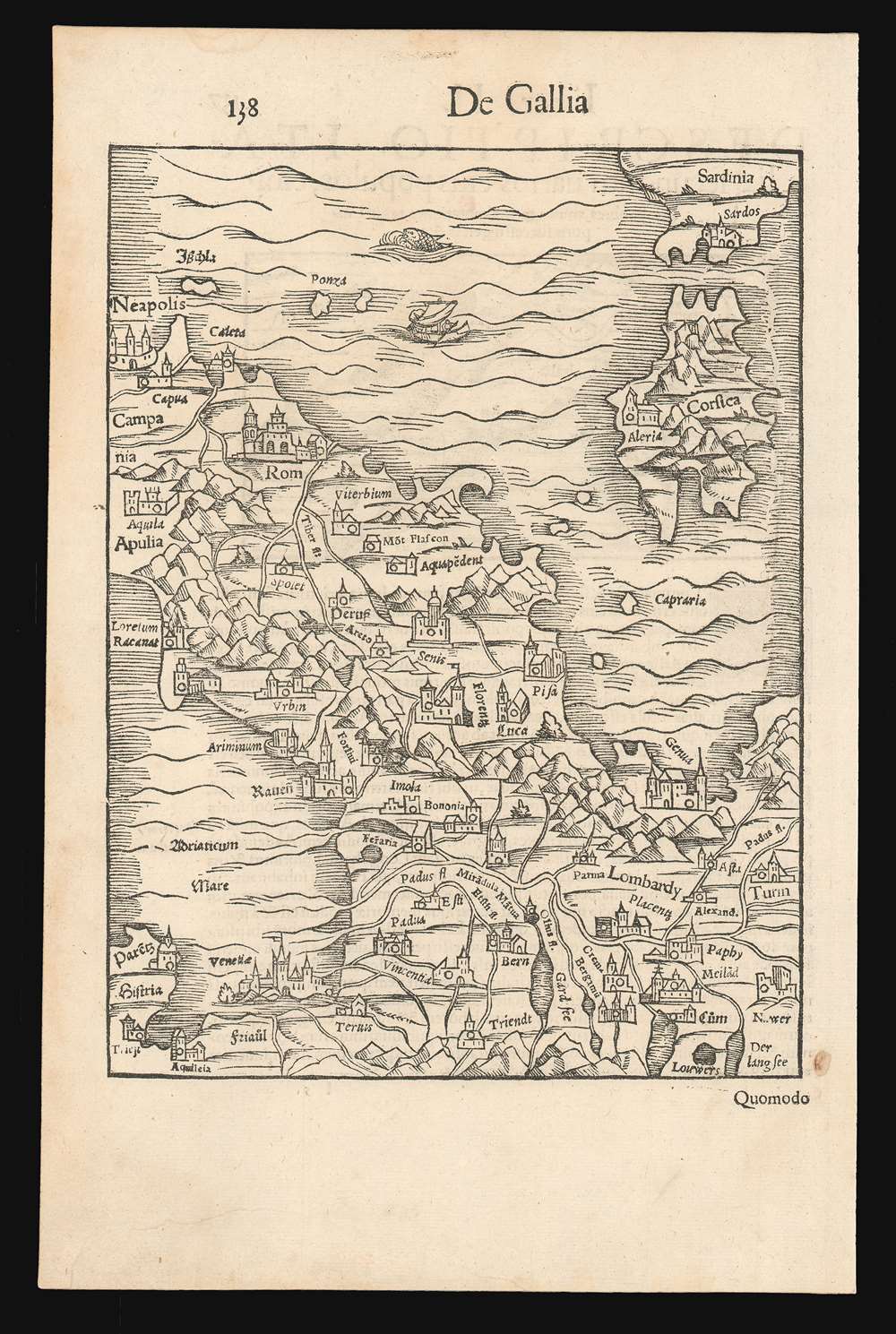This item has been sold, but you can get on the Waitlist to be notified if another example becomes available, or purchase a digital scan.
1554 Munster Map of Italy North of Rome, with Venice and Corsica
NorthItaly-munster-1554
Title
1554 (undated) 9.75 x 6.75 in (24.765 x 17.145 cm) 1 : 3174843
Description
Southern Orientation on Münster’s Maps
Münster’s decision to orient many of his maps to the south was not whimsical, but the direct result of the modern methods used in their production. German instrument makers, surveyors and geographers in the first half of the 16th century used the sun to determine north and south: solar compasses of the period oriented their users towards the equator, and maps derived from measurements based on solar observation shared that orientation. In Munster’s 1528 Erklerung des newen Instruments der Sunnen, Munster provided a primer of topographic surveying and mapping using solar instruments. Maps produced using the methodology he prescribed (for example, the map of the Heidelberg which he included in the text) were oriented towards the south. Such maps of this period produced in the southern hemisphere were likewise oriented to the equator – and consequently were oriented towards the north.More than a primer, Münster’s 1528 work was a manifesto advocating collaborative cartography based on rigorous scientific principles. Münster positioned himself as the editor of a new work of cartography, and called to the scholarly world to send him illustrations, text materials, and new maps produced using his methodology. These maps, appearing in both Münster’s 1540 Geographia and his 1544 Cosmographia, are oriented towards the south: in other words, the southern orientation of these regional maps marks them as the product of modern scientific survey, supplanting the legacy of maps passed down to 16th century geographers from Ptolemy. Beyond this advance in the production of new maps, Münster’s contribution to the future of cartography lies in his formalization of his role as editor, relying chiefly on eyewitness reports from multiple sources and heralding the evolution of cartography into a scientific discipline and laying the foundations for the atlases of later masters such as Mercator and Ortelius.
Publication History and Census
The map appeared in Münster's Cosmographia, and appears to have been added to the often-updated work as early as 1550. Cosmographia was wildly successful, remaining in print long after Munster's death of the plague in 1552.Cartographer
Sebastian Münster (January 20, 1488 - May 26, 1552), was a German cartographer, cosmographer, Hebrew scholar and humanist. He was born at Ingelheim near Mainz, the son of Andreas Munster. He completed his studies at the Eberhard-Karls-Universität Tübingen in 1518, after which he was appointed to the University of Basel in 1527. As Professor of Hebrew, he edited the Hebrew Bible, accompanied by a Latin translation. In 1540 he published a Latin edition of Ptolemy's Geographia, which presented the ancient cartographer's 2nd century geographical data supplemented systematically with maps of the modern world. This was followed by what can be considered his principal work, the Cosmographia. First issued in 1544, this was the earliest German description of the modern world. It would become the go-to book for any literate layperson who wished to know about anywhere that was further than a day's journey from home. In preparation for his work on Cosmographia, Münster reached out to humanists around Europe and especially within the Holy Roman Empire, enlisting colleagues to provide him with up-to-date maps and views of their countries and cities, with the result that the book contains a disproportionate number of maps providing the first modern depictions of the areas they depict. Münster, as a religious man, was not producing a travel guide. Just as his work in ancient languages was intended to provide his students with as direct a connection as possible to scriptural revelation, his object in producing Cosmographia was to provide the reader with a description of all of creation: a further means of gaining revelation. The book, unsurprisingly, proved popular and was reissued in numerous editions and languages including Latin, French, Italian, and Czech. The last German edition was published in 1628, long after Münster's death of the plague in 1552. Cosmographia was one of the most successful and popular books of the 16th century, passing through 24 editions between 1544 and 1628. This success was due in part to its fascinating woodcuts (some by Hans Holbein the Younger, Urs Graf, Hans Rudolph Manuel Deutsch, and David Kandel). Münster's work was highly influential in reviving classical geography in 16th century Europe, and providing the intellectual foundations for the production of later compilations of cartographic work, such as Ortelius' Theatrum Orbis Terrarum Münster's output includes a small format 1536 map of Europe; the 1532 Grynaeus map of the world is also attributed to him. His non-geographical output includes Dictionarium trilingue in Latin, Greek, and Hebrew, and his 1537 Hebrew Gospel of Matthew. Most of Munster's work was published by his stepson, Heinrich Petri (Henricus Petrus), and his son Sebastian Henric Petri. More by this mapmaker...

